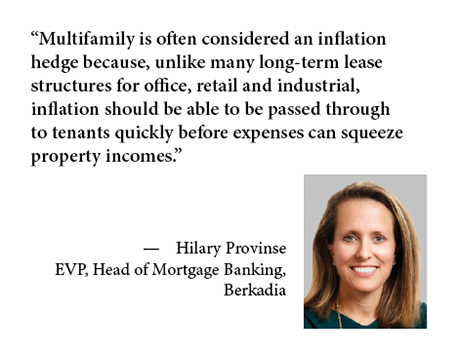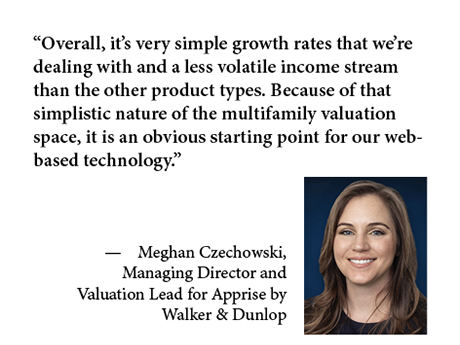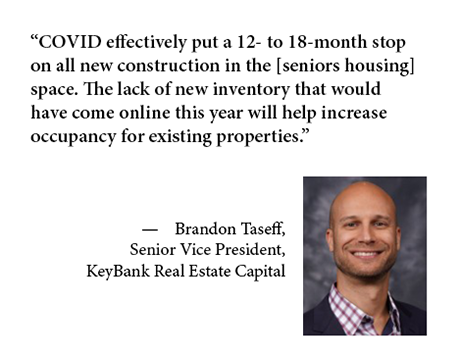In 2021, supply chain issues, increased costs, wage inflation and the logistical challenges of completing projects compounded to negatively impact the affordable housing pipeline. According to Gregg Gerken, head of U.S. Commercial Real Estate with TD Bank, 2022 looks fantastic for the affordable housing sector as those issues are beginning to resolve. However, he notes that the affordable housing sector is still challenged by delays related to financing challenges, among other factors. Demand for affordable housing, federal level commitments to the sector and the continued involvement of Fannie Mae and Freddie Mac are all positive factors for the outlook of affordable housing. However, Gerken notes, “Financing is somewhat challenged by gaps in funding. With pricing and costs going up, there’s a gap between how much a project might support from a loan side versus how much in tax credits are allocated to that project during the last round of allocations. Some of that gap between overall costs and the funding sources is being made up as local agencies put in additional money in order to get affordable housing done.” Hear what Gerken has to say about the development of workforce and affordable housing and the involvement of government-sponsored …
Finance Insight
Content PartnerFinance InsightLoansMidwestMultifamilyNortheastSoutheastTexasVideoWalker & DunlopWestern
Web-Based Appraisal Tool Supports Massive Increase in Demand for Multifamily Valuations
Multifamily appraisers are extremely busy as investor interest in the sector is at an all-time high. “In terms of appraisal professionals, there is a supply and demand issue,” explains Meghan Czechowski, managing director and valuation lead for Apprise by Walker & Dunlop. She notes that the industry has greater demand for valuation than it has qualified appraisers. “Apprise is ensuring that we can support our appraisal staff and our local market experts with a tech-enabled process so that they can do their jobs more efficiently and get the values (and market information in general) into our clients’ hands as quickly as possible,” she adds. Czechowski focuses on the ways that web-based multifamily valuations can be streamlined to create a faster and more complete picture of properties. Multifamily experts need information on properties/parcels that comes from “multiple industry-standard resources such as Yardi, REIS, RCA and public record aggregators.” Parcel-level information, unit mix metrics, sale leads, land records and site assessment information are all available through Apprise’s platform via a single sign on to a dashboard that reflects information that is constantly being updated. This means that when an expert uses this platform and picks up the phone to confirm about …
Surging payrolls, new household formations, growing barriers to homeownership and multifamily’s role as a hedge for inflation all helped fuel robust apartment fundamentals in 2021. With interest rates expected to rise in 2022, the question becomes: will the appetite for apartment investments remain strong for all types of investors and in which markets? Hilary Provinse, executive vice president and head of mortgage banking at Berkadia, says she sees many reasons to be enthusiastic about the opportunities in multifamily markets this year. “Fannie Mae and Freddie Mac will continue to set the standard for multifamily lending; however, strong life company, bank and debt fund appetites will compete heavily again in 2022. They will fill the needs not met by the government-sponsored enterprises (GSEs) or HUD.” When it comes to accelerating multifamily trends, Provinse sees an expansion in the scope of multifamily interest: “One of the trends we see accelerating (as a result of COVID) is increased investor demand in not only secondary markets, but even tertiary markets. This was a trend we had seen a decade ago, but now it’s on steroids.” “Because people can work from wherever now and because of more flexible work arrangements…we’ve seen this willingness to …
2021 was an exciting year in the multifamily financing market, and for Berkadia mortgage banking — we originated over $40 billion in volume for our clients across our various lender programs, an increase of 50 percent over our 2020 volumes. Every lender in the market demonstrated a strong appetite for originating loans and increased their holdings of mortgages, which was crucial given that the Federal Housing Finance Agency (FHFA) lowered the caps for Fannie Mae and Freddie Mac to $70 billion each. While the final numbers haven’t been released yet, the Mortgage Bankers Association (MBA) projected the market would originate $578 billion of loans backed by commercial real estate in 2021, a 31 percent increase from 2020 ($442 billion) and just below 2019’s record volume of $601 billion. The fundamentals of the multifamily sector drove unbelievable rent growth, which in turn drove increased investor interest. In 2021, we advised on 762 investment sales transactions, totaling close to $27 billion in volume, a truly record-breaking year for us! This tremendous investor appetite brought about an enhanced need for financing, and often more creative financing. With the government-sponsored enterprises (GSEs) more limited, life companies and commercial banks answered the call, but the …
The need for affordable housing has grown, but factors like municipal slowdowns and delays in financing have helped contribute to a lack of supply. Gregg Gerken, head of U.S. Commercial Real Estate with TD Bank, spoke to REBusiness about why the need for affordable housing is at a critical juncture and why this need is so difficult to fill. Finance Insight: What is the state of affordable housing right now? Gerken: There is a supply/demand imbalance. There continues to be a desperate need for more investment in affordable housing, not less. The arrival of COVID introduced more challenges for affordable housing, but the struggle to find high-quality affordable rental housing existed well before the pandemic. Rent prices affect millions of Americans, especially those with low incomes, and rents have only increased. Furthermore, the pandemic has caused an interruption of the supply chain and much-needed new projects have been delayed. Finance Insight: Can you outline a few big-picture national trends that are most impacting affordable housing right now? Gerken: As I mentioned, the imbalance of supply and demand is negatively affecting affordable housing. Rising rental rates mean fewer people will be able to qualify for affordable housing. Coming out of COVID …
Content PartnerFeaturesFinance InsightMidwestMultifamilyNortheastSoutheastTexasWalker & DunlopWestern
Web-Based Multifamily Valuation Enhances Speed, Builds Better Predictions
The future of multifamily valuation requires flexibility and the use of technology to process data faster and more reliably. Meghan Czechowski, managing director and valuation lead for Apprise by Walker & Dunlop, spoke to Finance Insight about why multifamily valuations in particular are well suited to a web-based machine learning approach, resulting in faster appraisals with increased reliability. Finance Insight: How does the Walker & Dunlop Apprise program differ from traditional residential valuation programs? Czechowski: We’re focused on multifamily with our tech-enabled process. Most appraisal reports on the commercial side (multifamily included, that is, five units and up) are completed using a web-based database, and those databases are typically blank slates. When you’re entering sale comparables, rent comparables or other data, most people are starting from scratch and usually using an analyst to record that comparable information that then feeds into a database. The Apprise team of appraisal experts uses our Apprise application, which is a proprietary web-based system. It uses the property record database; therefore, it is not a blank slate. It has over 2.5 million multifamily records flowing into it from a public record aggregator and various industry resources like REIS, RCA and Yardi, using direct integration and …
Content PartnerFeaturesFinance InsightMidwestMultifamilyNortheastSeniors HousingSoutheastTexasWestern
Investment, Financing in Seniors Housing Driven by Property Performance
If there were one phrase to summarize the attitude of seniors housing investors and lenders in 2022, it would be “cautiously optimistic.” How quickly can the seniors housing industry hope to recover in the face of continued difficulties? What is likely to drive the financing and investment market? While difficulties due to COVID and labor shortages continue to create challenges in terms of immediate occupancy, strong demand fundamentals and a healthy appetite for seniors housing investments indicate a return to normality is possible in 2022, according to Brandon Taseff, senior vice president, and Lee Delaveris, vice president on KeyBank Real Estate Capital’s team. Headwinds, Tailwinds in Seniors Housing The headwinds for seniors housing investment and development should not be dismissed, Taseff indicates. Staffing issues, the Omicron variant, slow occupancy growth and sluggish absorption of senior living units have made for slow going in the market with acquisition, development and financing activity remaining below normal levels. 2021 saw many positive factors to counter these impediments: widespread vaccination, a rebound in occupancy and a strengthened capital market interest in seniors housing. 2022 may be able to continue this momentum, explains Delaveris. “There are a lot of good reasons to think the industry will …
Challenges abound for seniors housing: occupancies at historic lows, widespread outbreaks in 2020, steeply increased operating expenses all contribute to the industry difficulties Matt Pipitone, Seniors Housing Platform manager, M&T Realty Capital Corp., outlines when discussing the seniors housing outlook for 2021. When discussing this year and what needs to happen for the industry to recover, Pipitone explains, “The focus will be on the occupancy rebound. How much pent-up demand is there? We expect there to be some improvement in the near-term occupancies as they start climbing back towards more stabilized levels. However, it remains to be seen how quickly things will ramp back up. Each market will be different.” How have occupancy pressures impacted rents and incentives? How will newer projects continue to lease up? Pipitone knows there are many questions, but says “Overall, we hope to see things gradually improve throughout the rest of 2021. We still have a lot of confidence in our clients. They’re resilient, passionate about their residents (and residents’ families and staff) and they’ll persevere.” Watch as Pipitone discusses Fannie, Freddie, refinancing, bank involvement, lasting impacts from the pandemic and much more. This article is posted as part of REBusinessOnline’s Finance Insight series. Click here to …
Ralph Cram, President of Envoy Net Lease Partners, LLC, is seeing dramatic change in the net lease space in 2021: in the past couple months he’s seen cap rates with 25 to 35 basis point drops on active deals, increased 1031 exchange activity and robust interest in net-lease properties. “What we’ve really seen in the last six months is the demand for investment-grade, net-lease properties has skyrocketed — partly because people aren’t buying nonessential or non-investment-grade tenants.” There is a supply constraint though: with many 2020 projects delayed, Cram anticipates 12 months before supply can reach the market — making for a tight market. Finance criteria for net lease clients, construction loan programs, development risks, outlining the process for lending overall and 2021 goals are concepts covered in this video interview for Finance Insight. This article is posted as part of REBusinessOnline’s Finance Insight series. Click here to subscribe to the Finance Insight newsletter, a four-part newsletter series, followed by video interviews delivered to your inbox in March.
Affordable HousingBuild-to-RentFinance InsightLoansMidwestMultifamilyNortheastSingle-Family RentalSoutheastTexasVideoWestern
NorthMarq: 2021 Capital Markets Environment
NorthMarq executives recently connected with nearly 50 correspondent lenders and more than 150 debt experts in an effort to better understand the capital markets environment in 2021 and to share information about opportunities within the market. Jeff Erxleben, executive vice president and executive managing director, Debt & Equity, with NorthMarq, shares some of the insights from those conversations, and he discusses changes in the market, ranging from new loan programs by life companies to the impact of FHA/HUD’s new MAP guide implemented this month. He also talks about the growing interest in single-family rental and build-for-rent properties, and he mentions trends in affordable housing development and value-add strategy for buyers of affordable and workforce housing. “Overall, we’ve seen strong volume at the beginning of 2021, and I would expect that to continue throughout the year as the liquidity in the debt and equity markets remains strong,” Erxleben notes. “Transaction volume is up; there is a large sentiment that there is pent-up demand to get deals done.” He adds, “We’re seeing the fastest rebound and largest amount of activity in high-growth, business-friendly Sunbelt states — Texas, Florida, Arizona and the Carolinas. Other states, like California, where activity has been more …
Newer Posts





